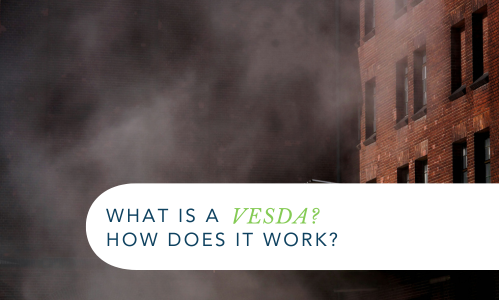When discussing fire equipment, you may frequently encounter acronyms such as FIP, ABE, CO2, and MCP but then there is VESDA, which you might be curious about. VESDA stands for Very Early Smoke Detection Apparatus and represents one of the most innovative technologies aimed at improving fire detection.
Generally, installed fire safety equipment is tailored to the specific needs of each facility. The VESDA is no exception and is used across facilities in a variety of industries.
How does VESDA work?
VESDA, or Very Early Smoke Detection Apparatus, is a specialised air sampling smoke detection system that utilises advanced technology to detect even the slightest traces of smoke in its earliest stages. Unlike smoke detectors, VESDA employs a network of sampling pipes strategically installed throughout a facility. These pipes continuously draw air samples into a central detection unit for analysis.
At the heart of the VESDA system is an aspiration unit, which includes a smoke sensor, a fan, and a network of pipes. The fan pulls air from the protected area via the pipes into the unit, where it passes through a laser detection chamber capable of detecting particles as small as 0.3 microns which is significantly smaller than what traditional smoke detectors can detect.
The sampled air undergoes analysis for smoke particles, and if the concentration exceeds a pre-set threshold tailored to each facility’s specific needs, the system triggers an alarm. This then alerts building occupants and initiates appropriate responses for that facility via an alarm system.
Where is a VESDA system installed?
A VESDA would typically be installed in various locations within a facility where early detection of smoke is crucial for safety and protection against fire hazards.
Common areas for installing VESDA systems include:
- Data Centres: To protect sensitive electronic equipment from potential fire damage.
- Telecommunication Facilities: To safeguard critical communication infrastructure.
- Sterile Rooms: To maintain the integrity of controlled environments in industries like pharmaceuticals.
- Museums: To preserve valuable artifacts and documents.
- Hospitals: To protect patients, staff, and medical equipment.
- Warehouses: To safeguard inventory and storage facilities.
- Power Generation Facilities: To prevent fire hazards in power plants.
- Transportation Hubs: To enhance safety in airports, train stations, and bus terminals.
- Industrial Facilities: To detect smoke in manufacturing plants, refineries, and chemical processing plants.
These installations are strategically planned based on the layout, size, and specific fire safety requirements of each facility.
So, now when you see VESDA in a workplace you’ll be sure to know that you are covered by one of the most innovative technologies in early smoke detection!
Click the following links for information on Fire Training, Emergency Training or Emergency Plans.
For questions, or to speak with one of our Trainers & Consultants, get in touch today!
GET IN TOUCH
Are you ready for peace of mind that your workforce is as safe and prepared as possible?
With a dedicated team of staff ready to help you meet compliance requirements and improve the overall safety of your workplace, all you need to do is get in touch.
Request your free audit today!



